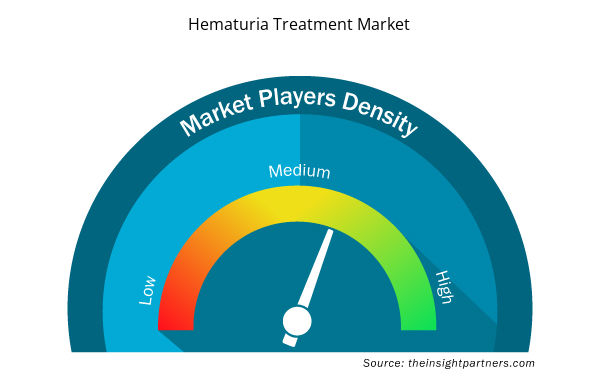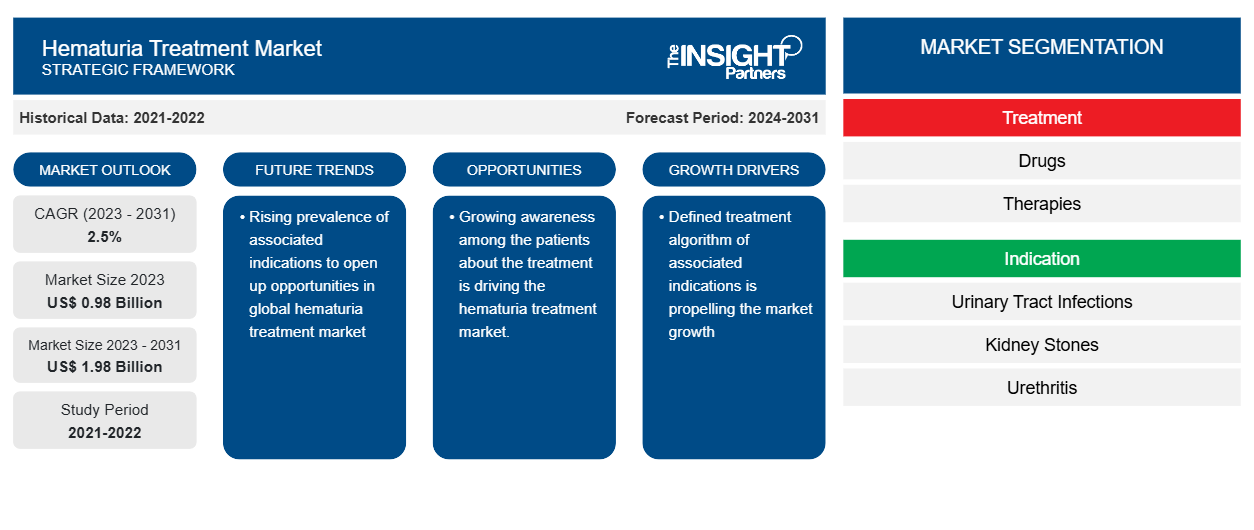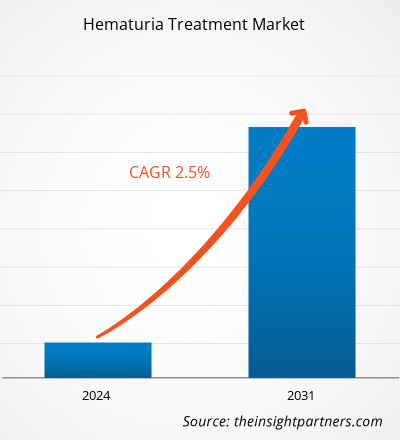血尿治療の市場規模は、2023年の9億8,000万米ドルから2031年には19億8,000万米ドルに達すると予測されています。市場は2023年から2031年にかけて2.5%のCAGRを記録すると予想されています。先進的な治療法への嗜好の高まりは、今後も市場の主要なトレンドであり続けると思われます。
血尿治療市場分析
市場の成長を牽引している主な要因は、血尿関連症状の有病率の高さ、治療オプションに関する認識の高まり、医療費の改善であり、これらは血尿治療市場を推進する要因です。さらに、医療機器や診断手順の技術開発により、腎臓結石、膀胱結石、尿路感染症などの血尿関連症状を管理するためのさまざまなオプションが生まれており、今後数年間で血尿治療市場にチャンスをもたらす可能性があります。
血尿治療市場の概要
慢性腎臓病(CKD)は、世界中でより多くの人が罹患している、一般的で生命を脅かす病気です。CKDには、腎結石、糸球体腎炎、多発性嚢胞腎、尿路感染症など、さまざまな種類があります。CKDは、血尿の蔓延の根本的な原因の1つです。たとえば、2019年5月に国立生物工学情報センターで発表された研究によると、尿路感染症(UTI)は米国では一般的に外来感染症として見られ、主に14歳から24歳の年齢層の女性に発生しています。さらに、65歳以上の女性のUTIの有病率は、全体の人口が約11%であるのに対し、約20%です。現在、世界の血尿治療市場は、関連する適応症の有病率の増加から大幅に利益を得ています。
要件に合わせてレポートをカスタマイズする
このレポートの一部、国レベルの分析、Excelデータパックなど、あらゆるレポートを無料でカスタマイズできます。また、スタートアップや大学向けのお得なオファーや割引もご利用いただけます。
- このレポートの主要な市場動向を入手してください。この無料サンプルには、市場動向から見積もりや予測に至るまでのデータ分析が含まれます。
血尿治療市場の推進要因と機会
治療選択肢に関する認識を高め、医療費支出を改善する
慢性疾患の罹患率の上昇により、医療費は大幅に増加しています。各国政府は医療インフラの改善に多額の投資を行っています。例えば、2020年12月に米国メディケア・メディケイドサービスセンター(CMS)が発表したデータによると、国民医療費(NHE)は約4.6%増加し、1人当たり11,582米ドルとなり、国内総生産(GDP)の約17.7%を占めました。さらに、CMSは、米国の医療費が2020年4月に約6.19兆米ドルに達すると予測しています。
さらに、先進国の患者は、血尿治療の可能な治療法と、その治療費の払い戻しの有無に気づき始めています。血尿は、血液がん、膀胱がん、腎臓がんなどの慢性疾患の初期症状の 1 つです。これらの疾患はさまざまな健康保険の対象となっており、患者の治療を楽にし、医療費の負担を軽減するのに役立ちます。したがって、医療費の削減と治療に関する患者の意識の向上が、血尿治療市場を牽引しています。
関連治療の機会の増加
腎結石や尿路感染症の増加により血尿疾患を発症する可能性が高くなる高齢化人口は、市場拡大を推進する主な要因の1つです。高度な治療技術の使用により、患者ケアが向上することが期待されています。たとえば、尿路結石症の治療のための手術にロボットを導入することが近年人気を集めています。現在、Intuitive Surgical Inc.のVinci Surgical Systemは、尿路結石症の治療のための手術に広く使用されています。同様に、腎結石に対する内視鏡的泌尿器科的介入の採用は、北米、ヨーロッパ、アジアのさまざまな国で大幅に増加しています。また、予測期間中、関連する適応症の進歩が世界の血尿治療市場を支えることが期待されています。
血尿治療市場レポートのセグメンテーション分析
血尿治療市場分析の導出に貢献した主要なセグメントは、製品タイプ、適応症タイプ、およびエンドユーザーです。
- 治療に基づいて、血尿治療市場は薬物、療法、その他に分類されます。薬物セグメントは2023年に最大の市場シェアを占めました。
- 適応症に基づいて、血尿治療市場は、尿路感染症、腎臓結石、尿道炎、血液がん、膀胱結石、前立腺がん、膀胱炎、外傷、激しい運動、多発性嚢胞腎、子宮内膜症、月経に分類されます。尿路感染症セグメントは、2023年に最大の市場シェアを占めました。
- エンドユーザーに基づいて、血尿治療市場は、病院、診療所、ASCなどによってセグメント化されています。病院のセグメントは、2023年に最大の市場シェアを占めました。
血尿治療市場シェアの地域別分析
血尿治療市場レポートの地理的範囲は、主に北米、アジア太平洋、ヨーロッパ、中東およびアフリカ、南米および中米の 5 つの地域に分かれています。
北米では、米国が最大の血尿治療市場です。この市場の成長は、慢性腎臓病(CKD)の罹患率の増加と主要企業による製品発売数の増加が主な要因です。たとえば、2016年に米国疾病予防管理センター(CDC)は、米国で末期腎不全(ESRD)の治療を受けた人は推定70万人であると述べました。ESRDの罹患率は、1990年から2016年の間に2倍以上に増加しました。さらに、成人の血尿発症率の増加、認知度の急上昇、広範な研究開発活動も血尿治療の普及を促進すると予想されており、最終的には市場の成長にとって有利な機会を提供するでしょう。
血尿治療市場の地域別洞察
予測期間を通じて血尿治療市場に影響を与える地域的な傾向と要因は、Insight Partners のアナリストによって徹底的に説明されています。このセクションでは、北米、ヨーロッパ、アジア太平洋、中東、アフリカ、南米、中米にわたる血尿治療市場のセグメントと地理についても説明します。

- 血尿治療市場の地域別データを入手
血尿治療市場レポートの範囲
| レポート属性 | 詳細 |
|---|---|
| 2023年の市場規模 | 9億8千万米ドル |
| 2031年までの市場規模 | 19億8千万米ドル |
| 世界のCAGR(2023年~2031年) | 2.5% |
| 履歴データ | 2021-2022 |
| 予測期間 | 2024-2031 |
| 対象セグメント | 治療方法別
|
| 対象地域と国 | 北米
|
| 市場リーダーと主要企業プロフィール |
|
血尿治療市場のプレーヤー密度:ビジネスダイナミクスへの影響を理解する
血尿治療市場は、消費者の嗜好の変化、技術の進歩、製品の利点に対する認識の高まりなどの要因により、エンドユーザーの需要が高まり、急速に成長しています。需要が高まるにつれて、企業は提供を拡大し、消費者のニーズを満たすために革新し、新たなトレンドを活用し、市場の成長をさらに促進しています。
市場プレーヤー密度とは、特定の市場または業界内で活動している企業または会社の分布を指します。これは、特定の市場スペースに、その市場規模または総市場価値に対してどれだけの競合相手 (市場プレーヤー) が存在するかを示します。
血尿治療市場で事業を展開している主要企業は次のとおりです。
- アストラゼネカ
- メルク社
- ブリストル・マイヤーズスクイブ社
- メルク社
- F. ホフマン・ラ・ロッシュ株式会社
- グラクソ・スミスクライン
免責事項:上記の企業は、特定の順序でランク付けされていません。

- 血尿治療市場のトップキープレーヤーの概要を入手
血尿治療市場のニュースと最近の動向
血尿治療市場は、主要な企業出版物、協会データ、データベースを含む一次調査および二次調査後の定性的および定量的データを収集することによって評価されます。血尿治療市場におけるいくつかの動向を以下に示します。
- アストラゼネカのファルシーガ(ダパグリフロジン)は、心不全(HF)の成人における心血管死(CV)のリスク、心不全(CHF)による入院、および心不全(HF)の緊急受診のリスクを軽減する薬として米国で承認されました。米国食品医薬品局(FDA)による承認は、DELIVER第3相試験の良好な結果に基づいています。1 ファルシーガは、米国で以前に、駆出率低下型HF(HFrEF)の成人の治療薬として承認されています。(出典:アストラゼネカ、企業ウェブサイト、2023年5月)
血尿治療市場レポートの対象範囲と成果物
「血尿治療市場の規模と予測(2021〜2031年)」レポートでは、以下の分野をカバーする市場の詳細な分析を提供しています。
- 血尿治療市場の規模と予測(対象範囲に含まれるすべての主要市場セグメントの世界、地域、国レベル)
- 血尿治療市場の動向、推進要因、制約、主要な機会などの市場動向
- 詳細なPEST/ポーターの5つの力とSWOT分析
- 主要な市場動向、世界および地域の枠組み、主要プレーヤー、規制、最近の市場動向を網羅した血尿治療市場分析。
- 市場集中、ヒートマップ分析、主要プレーヤー、血尿治療市場の最近の動向を網羅した業界展望と競争分析
- 詳細な企業プロフィール
- 過去2年間の分析、基準年、CAGRによる予測(7年間)
- PEST分析とSWOT分析
- 市場規模価値/数量 - 世界、地域、国
- 業界と競争環境
- Excel データセット


- Employment Screening Services Market
- Identity Verification Market
- Quantitative Structure-Activity Relationship (QSAR) Market
- Advanced Planning and Scheduling Software Market
- Aircraft MRO Market
- Cling Films Market
- Wind Turbine Composites Market
- Wheat Protein Market
- Biopharmaceutical Contract Manufacturing Market
- Ketogenic Diet Market

Report Coverage
Revenue forecast, Company Analysis, Industry landscape, Growth factors, and Trends

Segment Covered
This text is related
to segments covered.

Regional Scope
North America, Europe, Asia Pacific, Middle East & Africa, South & Central America

Country Scope
This text is related
to country scope.
よくある質問
North America dominated the hematuria treatment market in 2023
The key factors that are driving the growth of the market are the high prevalence of hematuria-associated indications, increasing awareness about treatment options, and improving healthcare expenditure are factors propelling the hematuria treatment market.
A rise in Preference for Advanced Therapies will likely remain a key trend in the market.
AstraZeneca, Merck & Co., Inc., Bristol-Myers Squibb Company, Merck & Co., Inc., F. HOFFMANN-LA ROCHE LTD., GlaxoSmithKline plc., Janssen Pharmaceuticals, Novartis AG, Pfizer Inc., Boehringer Ingelheim International GmbH.
The market is expected to register a CAGR of 2.5% during 2023–2031.
Trends and growth analysis reports related to Life Sciences : READ MORE..
The Insight Partners performs research in 4 major stages: Data Collection & Secondary Research, Primary Research, Data Analysis and Data Triangulation & Final Review.
- Data Collection and Secondary Research:
As a market research and consulting firm operating from a decade, we have published and advised several client across the globe. First step for any study will start with an assessment of currently available data and insights from existing reports. Further, historical and current market information is collected from Investor Presentations, Annual Reports, SEC Filings, etc., and other information related to company’s performance and market positioning are gathered from Paid Databases (Factiva, Hoovers, and Reuters) and various other publications available in public domain.
Several associations trade associates, technical forums, institutes, societies and organization are accessed to gain technical as well as market related insights through their publications such as research papers, blogs and press releases related to the studies are referred to get cues about the market. Further, white papers, journals, magazines, and other news articles published in last 3 years are scrutinized and analyzed to understand the current market trends.
- Primary Research:
The primarily interview analysis comprise of data obtained from industry participants interview and answers to survey questions gathered by in-house primary team.
For primary research, interviews are conducted with industry experts/CEOs/Marketing Managers/VPs/Subject Matter Experts from both demand and supply side to get a 360-degree view of the market. The primary team conducts several interviews based on the complexity of the markets to understand the various market trends and dynamics which makes research more credible and precise.
A typical research interview fulfils the following functions:
- Provides first-hand information on the market size, market trends, growth trends, competitive landscape, and outlook
- Validates and strengthens in-house secondary research findings
- Develops the analysis team’s expertise and market understanding
Primary research involves email interactions and telephone interviews for each market, category, segment, and sub-segment across geographies. The participants who typically take part in such a process include, but are not limited to:
- Industry participants: VPs, business development managers, market intelligence managers and national sales managers
- Outside experts: Valuation experts, research analysts and key opinion leaders specializing in the electronics and semiconductor industry.
Below is the breakup of our primary respondents by company, designation, and region:

Once we receive the confirmation from primary research sources or primary respondents, we finalize the base year market estimation and forecast the data as per the macroeconomic and microeconomic factors assessed during data collection.
- Data Analysis:
Once data is validated through both secondary as well as primary respondents, we finalize the market estimations by hypothesis formulation and factor analysis at regional and country level.
- Macro-Economic Factor Analysis:
We analyse macroeconomic indicators such the gross domestic product (GDP), increase in the demand for goods and services across industries, technological advancement, regional economic growth, governmental policies, the influence of COVID-19, PEST analysis, and other aspects. This analysis aids in setting benchmarks for various nations/regions and approximating market splits. Additionally, the general trend of the aforementioned components aid in determining the market's development possibilities.
- Country Level Data:
Various factors that are especially aligned to the country are taken into account to determine the market size for a certain area and country, including the presence of vendors, such as headquarters and offices, the country's GDP, demand patterns, and industry growth. To comprehend the market dynamics for the nation, a number of growth variables, inhibitors, application areas, and current market trends are researched. The aforementioned elements aid in determining the country's overall market's growth potential.
- Company Profile:
The “Table of Contents” is formulated by listing and analyzing more than 25 - 30 companies operating in the market ecosystem across geographies. However, we profile only 10 companies as a standard practice in our syndicate reports. These 10 companies comprise leading, emerging, and regional players. Nonetheless, our analysis is not restricted to the 10 listed companies, we also analyze other companies present in the market to develop a holistic view and understand the prevailing trends. The “Company Profiles” section in the report covers key facts, business description, products & services, financial information, SWOT analysis, and key developments. The financial information presented is extracted from the annual reports and official documents of the publicly listed companies. Upon collecting the information for the sections of respective companies, we verify them via various primary sources and then compile the data in respective company profiles. The company level information helps us in deriving the base number as well as in forecasting the market size.
- Developing Base Number:
Aggregation of sales statistics (2020-2022) and macro-economic factor, and other secondary and primary research insights are utilized to arrive at base number and related market shares for 2022. The data gaps are identified in this step and relevant market data is analyzed, collected from paid primary interviews or databases. On finalizing the base year market size, forecasts are developed on the basis of macro-economic, industry and market growth factors and company level analysis.
- Data Triangulation and Final Review:
The market findings and base year market size calculations are validated from supply as well as demand side. Demand side validations are based on macro-economic factor analysis and benchmarks for respective regions and countries. In case of supply side validations, revenues of major companies are estimated (in case not available) based on industry benchmark, approximate number of employees, product portfolio, and primary interviews revenues are gathered. Further revenue from target product/service segment is assessed to avoid overshooting of market statistics. In case of heavy deviations between supply and demand side values, all thes steps are repeated to achieve synchronization.
We follow an iterative model, wherein we share our research findings with Subject Matter Experts (SME’s) and Key Opinion Leaders (KOLs) until consensus view of the market is not formulated – this model negates any drastic deviation in the opinions of experts. Only validated and universally acceptable research findings are quoted in our reports.
We have important check points that we use to validate our research findings – which we call – data triangulation, where we validate the information, we generate from secondary sources with primary interviews and then we re-validate with our internal data bases and Subject matter experts. This comprehensive model enables us to deliver high quality, reliable data in shortest possible time.


 このレポートの無料サンプルを入手する
このレポートの無料サンプルを入手する